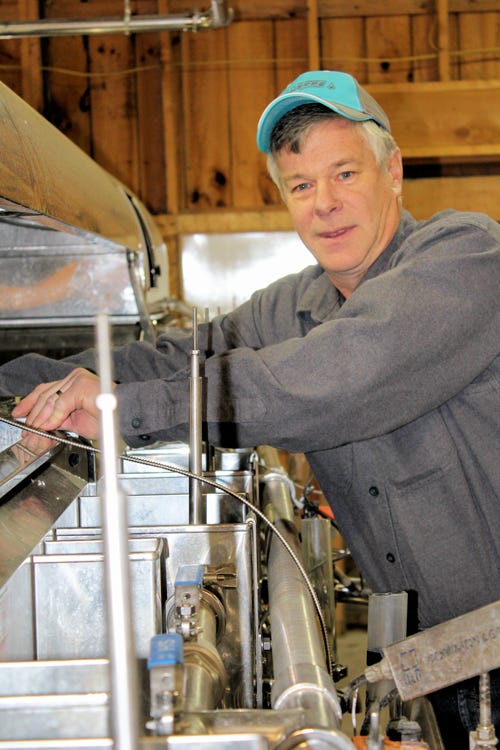January 3, 2018

When Fletcher, Vt., sugar-maker Rick Mayotte’s sap production began overwhelming his sugarhouse setup, he knew it was time to upgrade. He looked into a system that included a high-concentration reverse osmosis primarily to save fuel.
These new systems remove enough water to produce sap with sugar concentrations of 35% or more while demanding much less energy than conventional reverse osmosis (RO). At first, this northern Vermonter was a little worried about losing flavor. And would the syrup maintain the same high quality?
There was a lot on the line. Mayotte processes sap from 70,000 taps, including 54,000 of his own, and he has steadily added taps. For the last 40 years, he has sold all his syrup directly to Butternut Mountain Farm at Johnson, Vt.
Before the 2017 season, Mayotte installed a LaPierre HyperBrix RO, along with a new second RO plus a second evaporator. That move doubled his production capacity and sliced his fuel bill in half.
He’s confident he’ll do even better this year. “It’s a different process — enhancing conventional RO technology with different membranes and filters.” The RO concentrates sap at a much higher level, while the new evaporator maintains good-quality flavor.
Results not surprising
University of Vermont’s Proctor Maple Research Center has been studying high-concentrate RO systems for several years. Because the time sap spends in the evaporator can affect caramelization and taste, one of Proctor’s research projects looked at syrup flavor. It found that syrup made with the high-concentrate RO system tasted just as good as syrup from a conventional RO.
In Mayotte’s operation, sap goes through the conventional RO first, concentrating it to 17% sugar. Then it goes through the HyperBrix, where it’s concentrated to 32%, and finally moved into the new 6-by-16-foot evaporator. There, sap spends much less time in the flue pan compared to a conventional evaporator and more time in the front pans. “The evaporator doubles the flat pan area, which is where the caramelization and flavor come from,” Mayotte explains.

FUEL-SAVER: This high-concentrate RO system helped halve fuel use and double Rick Mayotte’s syrup production capacity.

High sugar content means it takes much less time to boil sap down into a final product. Taking raw sap to 35% sugar before boiling allows Mayotte to produce from 220 to 240 gallons of syrup an hour.
His old 4-by-14-foot evaporator is still used to boil sap that has been concentrated to about 20% in his conventional RO.
The HyperBrix RO does suck up more electricity. But Mayotte’s new conventional RO is also more efficient than his old one, so his electric bill has stayed the same. He still keeps the old RO around, just in case. “Maple season’s very short,” he says. “I like to have redundancies in place.”
Cleaning the new system requires an extra step. And there was a learning curve; but LaPierre has provided good technical support, he says.
Fast-changing tech and industry
Other maple equipment companies have developed or are developing high-brix RO systems. RO systems are just one new type of equipment reshaping the maple world today, says Tim Perkins, Proctor research center director.
In the last 10 to 15 years, the industry has grown very quickly, partly due to increased demand, and partly as farmers seek economic alternatives to low milk and timber prices. Size of maple operations is growing, too, encouraging development of new technology.
“People want to save time and energy, so they need to be efficient,” Perkins says. Maple yields have doubled in just the past 20 years, from 1 quart of syrup from each tap to a half-gallon per tap.
Mayotte’s operation is a case in point. He started out with just 700 buckets. Today, he processes syrup from 100 times as many taps, all on tubing. He embraces new technologies such as a digital vacuum monitoring, which shows him when a vacuum goes down.
Mayotte’s new setup cost around $100,000. But he expects that to be paid back in just four years, depending on oil costs. “I’m saving time, a lot of energy and a lot of money,” he says.
“I wouldn’t tell everyone to go for it. But do your homework to make sure it fits your operation. It was the right choice for here.” One drawback is that you may need to invest in a whole new evaporator system, too. “It’s a tandem team,” Mayotte says.
Harlow writes from Westminster Station, Vt.
About the Author(s)
You May Also Like




